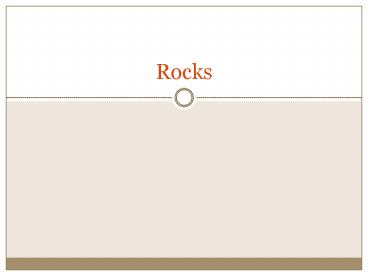Rocks - PowerPoint PPT Presentation
1 / 41
Title:
Rocks
Description:
Rocks Rocks, Part 3 Sedimentary Rocks Sedimentary From Latin sedimentum = settling Formed when sediments are compacted and cemented together Create a Sedimentary Rock ... – PowerPoint PPT presentation
Number of Views:18
Avg rating:3.0/5.0
Title: Rocks
1
Rocks
2
Whats a Rock?
- A solid chunk of one or more minerals (or
sometimes mineral-like matter)
3
The Rock Cycle
4
A Quick Quiz
- The type of rock that starts it all!
- IGNEOUS!
- A rock formed by squeezing and heating.
- METAMORPHIC
- A rock formed from smaller rocks and material
being compacted together. - SEDIMENTARY
5
More Questions!
- A rock formed from cooling magma or lava
- IGNEOUS
- A sedimentary rock might have originally been one
of this(these) kind of rock(s) - IGNEOUS, METAMORPHIC, or SEDIMENTARY
- A metamorphic rock might have originally been one
of this(these) kind of rock(s) - IGNEOUS or SEDIMENTARY
6
Rocks, Part 2
- Igneous Rocks
7
Igneous
- From Latin ignis FIRE!
- Formed when lava or magma cools and hardens
8
Examples of Igneous Rocks
9
Several Ways to Classify Igneous Rocks
- Intrusive vs. Extrusive
- Texture
- Composition
10
2. Texture
- Coarse Grain Texture
- Fine Grain Texture
- Glassy Texture
11
Coarse Grain Texture
- Relatively Large Crystals
- Formed by slow cooling of magma in Earth
12
Fine Grain texture
- Smaller Crystals
- Formed by rapid cooling of magma or lava
13
Glassy Texture
- Crystals so tiny the rock looks like glass
- Formed by extremely fast cooling of lava
14
3. Composition
- Granitic Composition
- Basaltic Composition
15
Granitic Composition
- Lots of light-colored silicates, esp. quartz and
feldspar - Usually speckled with about 10 dark silicates
- Make up most of continental crust
16
Basaltic Composition
- Mainly dark silicates
- Darker and denser than granite
- Make up most of ocean floor (formed at ocean
ridges)
17
Rocks, Part 3
- Sedimentary Rocks
18
Sedimentary
- From Latin sedimentum settling
- Formed when sediments are compacted and cemented
together
19
Create a Sedimentary Rock in Only 3 Steps!
- Step 1 Weather/erode parent rock and deposit
sediment. - Step 2 Compact sediment.
- Step 3 Cement sediment.
- Voila! Your sedimentary rock is complete.
20
Step 1 Weather/erode parent rock and deposit
sediment.
Table Mountain, South Africa
21
Step 2 Compact sediment.
- As sediments are buried, the increasing weight of
sediments above them squishes them together and
removes most water.
22
Step 3 Cementation.
- Finally, dissolved minerals are deposited in the
spaces between the sediments. The minerals
solidify and cement the particles together (like
mortar).
23
Examples of Sedimentary Rocks
Rounded, Gravel-sized Sediment
Conglomerate
24
Another Example
Angular Gravel-sized Sediment
Breccia
25
And Another
Sand-sized Sediment Grains
Sandstone
26
Sandstone in Architecture
The Treasury Petra, Jordan
And Its Still Used Today!
27
And Another Example
Fine-grained Sediment
Shale
28
More Sedimentary Rocks
Siltstone
Chalk
Limestone
29
A Special Word About Limestone
- Very common
- Main mineral Calcite (CaCO3)
- Often used as building material
- Often formed from marine organisms
30
Indiana Limestone in Buildings
AND 35 of 50 Statehouses made of Indiana
Limestone!
National Holocaust Museum
31
Why Studying Sedimentary Rocks is Useful
- Formed by adding successive layers
- Contents of layers tell a story of that time
- Fossils of organisms, floods, volcanoes,
earthquakes, climate
Limestone from Indiana???
A Trilobite Fossil
32
Rocks, Part 4
- Metamorphic Rocks
33
Metamorphic
- To change form due to heat and pressure
- Formed from either igneous or sedimentary rocks
34
The Role of Heat
- Provides energy to drive reactions between
minerals - Existing minerals may be re-crystallized into a
different form or new minerals may be formed - Source of heat
- Contact with magma itself
- Increasing depth (temperature increases 20-30oC
per kilometer)
35
Role of Pressure
- Farther down a rock is buried, the greater the
pressure - Increased pressure smooshes minerals together or
causes them to re-crystallize - Under high temp and pressure, rocks flow
instead of fracturing
36
Foliated vs. Nonfoliated Metamorphic Rocks
- Foliated striped
- Nonfoliated not striped
Gneiss
Marble
37
More Metamorphic Rocks
Slate
Shale
38
Another Meta
Gneiss
Granite
39
And Another
Marble
Limestone
40
One More
Quartzite
Sandstone
41
And Lastly
- Hornfels
- No specific composition
- Was baked by magma in contact the parent rock































